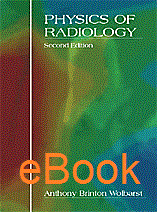
Physics of Radiology, Second Edition
Author: Anthony B. WolbarstISBN: 9781930524651
Published: 2005 | 660 pp | eBook
Price: $ 110.00
Table of Contents
Introduction- -Introduction to Medical Imaging
-Sketches of the Imaging Modalities
-X-Ray Imaging I:Overview of Film Radiography
- Appendix: The Role
of Medical Physics in an Imaging Department
Radiation and Matter
- -Mass, Motion, and Force
- Appendix:
Functions
-Magnetic Fields and Electromagnetic Waves
- Appendix: Periodic Functions
-Atoms and Photons
-Matter: Gases and Liquids, Metals, Superconductors, Insulators, and Semiconductors
-Resistors, Transistors, and All That:
An Introduction to Electronic Circuits
- Appendix: Exponential and Logarithmic
Functions
- -Ultrasound Imaging
I: Reflections of Acoustic Waves in Elastic Tissues
-Magnetic Resonance Imaging I:Nuclear Magnetic Resonance of Stable Hydrogen Nuclei in the Water Molecules of Tissues
-Gamma Ray Imaging I: Harnessing Radioactive Decay
- Appendix: Derivatives
of Functions
- Appendix: Probability
-X-ray Imaging III: Mapping Images on Film
-A Synthesis: Radioactive Decay, X-Ray Beam Attenuation, Nuclear Spin Relaxation, Cell Killing with Radiation, and other Poisson Processes
- -Image
Quality: Contrast, Resolution, and Noise - Primary Determinants of the Diagnostic Utility of an
Image
- Appendix: Statistics
-The Psychophysics of Optical Images
-Vacuum Tube and Solid-State Optical Cameras and Displays
-Digital Representation of an Image
- Appendix: Computer Basics and a Bit about Bytes
X-Ray Imaging IV: Creation of an X-Ray Beam
- -The Nuts and Bolts of X-
Ray Generators
-Design of an X-Ray Tube
-Transforming Electron Kinetic Energy into Bremsstrahlung and Characteristic X-Ray Energy
- -Creating the Primary X-Ray Image Within the Body
-Scatter Radiation, Grids, Gaps, and Contrast
-Capturing the Primary X-Ray Image with Cassette and Film
-Resolution and Magnification
-Optimal Technique Factors
-Radiographic Quality Assurance
-Screen-Film Mammography
-Some Infrequently Used Screen-Film Techniques
- -Following Time-Dependent
Processes with Fluoroscopy
X-Ray Imaging VII: Digital X- Ray Imaging
- -Digital Radiography, Computed Radiography, and Flat-Panel X-Ray
Technology
-Digital Fluoroscopy and Digital Subtraction Angiography
-Computed Tomography I: Creating a Map of CT Numbers
-Computed Tomography II: Image Reconstruction, Image Quality, and Dose
-Computed Tomography III: Spiral and Multi- Slice Scanning
- -Gamma Ray Imaging II:
Radiopharmaceuticals
- Appendix: Radioactive Transformations
-Gamma Ray Imaging IV: Nuclear Cardiology, SPECT, and PET
- -Magnetic Resonance
Imaging II: The Classical View of NMR
-Magnetic Resonance Imaging III: Relaxation Times (T1 and T2), Pulse Sequences, and Contrast
-Magnetic Resonance Imaging IV: Image Reconstruction and Image Quality
-Magnetic Resonance Imaging V: Fast, Flow, and Functional Imaging
-Magnetic Resonance VI: Biological Effects and Safety
- -Ultrasound Imaging II: Creating the Beam
-Ultrasound Imaging III: Image Production and Image Quality
-Ultrasound Imaging IV: Biological Effects and Safety
- -Evolving and Experimental
Technologies in Medical Imaging
Ionizing Radiation Dose, Biological Effects, and Risk
- -Radiation
Dose II: Determining Organ Doses from Exposure Measurements
-Radiation Dose III: The Tissue f-Factor, Tissue-Air Ratios, etc.
-Radiation Dose IV: Radiobiological Processes and Effects
-Radiation Dose V: Probabilities of Occurence of Stochastic Health Effects
- Appendix: On talking with People about Radiation (and Other)
Risks
- -Practical Radiation Safety for Ionizing
Radiation
-Rems, Risks, and Regs: The Legal Basis for Radiation Protection Standards
-Response to a Major Radiological Emergency
References
Some Symbols and Units
Index


